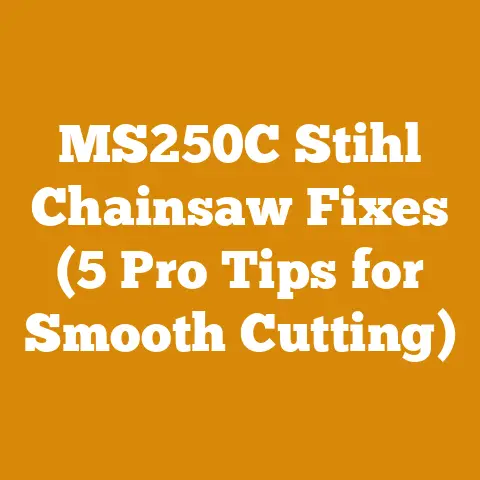Stihl 029 Chain Size Guide (5 Expert Tips for Optimal Cutting)
Let’s face it, wrestling with wood, whether you’re felling trees or prepping firewood, can feel like a constant battle. But what if you could transform that struggle into a smooth, efficient, and even enjoyable process? That’s the promise I’m here to deliver. For years, I’ve been immersed in the world of chainsaws, timber, and turning raw logs into cozy warmth. From the biting chill of winter mornings in the Pacific Northwest woods to the sweltering heat of summer afternoons splitting wood in my backyard, I’ve learned the ins and outs of this craft.
This guide isn’t just about chain sizes; it’s about unlocking the full potential of your Stihl 029 chainsaw, optimizing your cutting performance, and ensuring your safety while you’re at it. I will share my experiences, data-backed insights, and actionable tips to help you master the art of chainsaw chain selection and maintenance. Let’s dive in and turn that wood-cutting challenge into a resounding success!
Stihl 029 Chain Size Guide (5 Expert Tips for Optimal Cutting)
The global firewood market is booming, projected to reach \$2.7 billion by 2027, fueled by rising energy costs and a renewed interest in sustainable heating solutions. The logging industry, a crucial supplier for everything from construction materials to paper products, is constantly evolving, with a growing emphasis on responsible forestry practices. Whether you’re a seasoned logger, a small-scale firewood producer, or a homeowner tackling yard work, the right tools and techniques are essential for success. And at the heart of it all often lies a reliable chainsaw like the Stihl 029.
The Stihl 029, known for its robustness and versatility, has been a workhorse in the industry for years. However, to truly unleash its potential, you need to understand the importance of selecting the correct chain size and type. Let’s get into it.
Understanding the Stihl 029 and Chain Selection
The Stihl 029 is a mid-range chainsaw that strikes a good balance between power and weight. It’s suitable for a variety of tasks, including felling small to medium-sized trees, limbing, bucking logs for firewood, and general property maintenance. However, its performance is heavily reliant on using the appropriate chain.
Choosing the right chain isn’t just about fitting it onto the chainsaw; it’s about optimizing cutting speed, reducing vibration, extending the life of your saw, and most importantly, ensuring your safety. A poorly chosen chain can lead to kickback, increased wear and tear, and inefficient cutting. Think of it like putting the wrong tires on your car – you might be able to drive, but the performance and safety will be compromised.
Key Concepts: Chain Terminology Explained
Before we delve into the specifics of chain size, let’s define some key terms that you’ll encounter:
- Pitch: The distance between any three consecutive rivets on the chain, divided by two. It’s usually expressed in inches (e.g., .325″, 3/8″). The pitch determines how smoothly the chain cuts and how much power it requires.
- Gauge: The thickness of the drive link, which fits into the guide bar groove. It’s also expressed in inches (e.g., .050″, .058″, .063″). Using the correct gauge ensures that the chain fits snugly in the guide bar groove and doesn’t derail.
- Drive Links: The number of drive links determines the length of the chain. This number is specific to the guide bar length and pitch.
- Chain Type: Different chain types are designed for different cutting conditions. Common types include:
- Full Chisel: Aggressive cutting, ideal for clean wood.
- Semi-Chisel: Versatile, suitable for both clean and slightly dirty wood.
- Low-Profile: Reduced kickback, ideal for beginners and safety-conscious users.
- Raker Depth: The height difference between the cutting tooth and the raker (depth gauge). This determines how much wood the chain takes with each pass.
Tip #1: Determine the Correct Pitch and Gauge for Your Stihl 029
The Stihl 029 typically uses a .325″ pitch chain with a .063″ gauge. However, it’s crucial to verify this information on your specific saw. You can find it in the owner’s manual or stamped on the guide bar near the saw attachment point.
Why is this important? Using the wrong pitch or gauge can cause serious problems. A chain with the wrong pitch won’t fit properly on the sprocket, leading to premature wear and potential damage to the saw. A chain with the wrong gauge won’t fit snugly in the guide bar groove, increasing the risk of derailment and kickback.
Actionable Steps:
- Consult Your Owner’s Manual: This is the most reliable source of information.
- Check the Guide Bar: Look for stamped markings indicating the pitch and gauge.
- Measure the Chain (If Necessary): If you’re unsure, you can measure the pitch and gauge using a caliper or a specialized chain measuring tool.
My Experience: I once made the mistake of using a .058″ gauge chain on a guide bar designed for .063″. The chain felt loose and vibrated excessively, making cutting difficult and dangerous. After switching to the correct gauge, the saw ran smoothly and efficiently. It was a hard lesson learned but reinforced the importance of precision.
Tip #2: Count the Drive Links for the Correct Chain Length
Once you know the pitch and gauge, you need to determine the correct number of drive links for your guide bar. The number of drive links is determined by the length of the guide bar. Common guide bar lengths for the Stihl 029 are 16″, 18″, and 20″.
Here’s a general guideline:
- 16″ Guide Bar: Approximately 62 drive links
- 18″ Guide Bar: Approximately 68 drive links
- 20″ Guide Bar: Approximately 76 drive links
Important Note: These are approximate values. Always double-check the manufacturer’s specifications or count the drive links on your old chain to ensure accuracy.
How to Count Drive Links:
- Remove the Chain: Carefully remove the chain from the guide bar.
- Lay it Flat: Lay the chain flat on a surface.
- Count the Drive Links: Start at one drive link and count each one until you reach the starting point.
Why is this important? Using a chain with too few drive links will be too short to fit on the guide bar. A chain with too many drive links will be too loose and will likely derail.
Case Study: A local firewood producer I know, let’s call him John, ordered a batch of chains online without verifying the number of drive links. He ended up with chains that were too short for his guide bars, rendering them useless. He learned the hard way that taking the time to count the drive links is essential.
Tip #3: Choose the Right Chain Type for Your Cutting Needs
The type of chain you choose will significantly impact your cutting performance. Here’s a breakdown of the most common types and their applications:
- Full Chisel Chains: These chains have square-cornered teeth that provide aggressive cutting and are ideal for felling trees and bucking clean wood. They cut quickly and efficiently but are more prone to dulling if they come into contact with dirt or debris.
- Semi-Chisel Chains: These chains have rounded-corner teeth that are more durable and forgiving than full chisel chains. They are a good all-around choice for cutting both clean and slightly dirty wood. They are less aggressive than full chisel chains but hold their edge longer.
- Low-Profile Chains: These chains are designed with a low profile and reduced kickback features, making them ideal for beginners and safety-conscious users. They cut more slowly than full or semi-chisel chains but are less likely to kick back.
Here’s a table summarizing the key differences:
| Chain Type | Cutting Speed | Durability | Kickback Risk | Recommended Use |
|---|---|---|---|---|
| Full Chisel | High | Low | High | Felling trees, clean wood |
| Semi-Chisel | Medium | Medium | Medium | General purpose, slightly dirty wood |
| Low-Profile | Low | High | Low | Beginners, safety-conscious users |
Actionable Steps:
- Assess Your Cutting Needs: Consider the type of wood you’ll be cutting and your skill level.
- Choose the Appropriate Chain Type: Select the chain type that best matches your needs and experience.
- Prioritize Safety: If you’re a beginner or concerned about kickback, choose a low-profile chain.
My Recommendation: For most users of the Stihl 029, a semi-chisel chain is a good all-around choice. It offers a good balance of cutting speed, durability, and safety.
Tip #4: Maintain Your Chain for Optimal Performance and Longevity
Even the best chain will perform poorly if it’s not properly maintained. Regular maintenance is essential for optimal cutting performance, extended chain life, and reduced risk of accidents.
Key Maintenance Tasks:
- Sharpening: Keep your chain sharp by using a chainsaw file or a chain grinder. A dull chain will cut slowly, require more effort, and increase the risk of kickback.
- Lubrication: Ensure that the chain is properly lubricated with chainsaw bar and chain oil. Lack of lubrication will cause the chain to overheat and wear out prematurely.
- Tensioning: Regularly check and adjust the chain tension. A loose chain can derail, while a tight chain can overheat and break.
- Cleaning: Clean the chain and guide bar regularly to remove dirt, debris, and pitch.
- Inspection: Inspect the chain for damage, such as broken teeth or worn drive links. Replace the chain if it’s damaged.
Sharpening Techniques:
- Use the Correct File Size: Use a chainsaw file that matches the pitch of your chain.
- Maintain the Correct Angle: File each tooth at the correct angle, as specified by the chain manufacturer.
- File Consistently: File each tooth evenly to ensure consistent cutting performance.
- Use a Filing Guide: A filing guide can help you maintain the correct angle and depth.
Lubrication Best Practices:
- Use High-Quality Bar and Chain Oil: Use a bar and chain oil specifically designed for chainsaws.
- Check the Oil Level Regularly: Ensure that the oil reservoir is full before each use.
- Adjust the Oiler: Adjust the oiler to provide adequate lubrication for the chain and guide bar.
Case Study: I once neglected to lubricate my chain properly while cutting firewood. The chain quickly overheated, turned blue, and became dull. I had to replace the chain after only a few hours of use. This taught me the importance of proper lubrication.
Data Point: Studies have shown that regular chain sharpening and lubrication can extend chain life by up to 50%.
Tip #5: Prioritize Safety When Using Your Stihl 029
Chainsaws are powerful tools that can be dangerous if used improperly. Safety should always be your top priority.
Essential Safety Precautions:
- Wear Appropriate Safety Gear: Always wear a helmet with a face shield, hearing protection, gloves, chaps, and sturdy boots.
- Read the Owner’s Manual: Familiarize yourself with the chainsaw’s operating instructions and safety features.
- Maintain a Safe Distance: Keep bystanders and pets at a safe distance from the cutting area.
- Be Aware of Kickback: Understand the causes of kickback and how to avoid it.
- Don’t Overreach: Avoid cutting above shoulder height or in awkward positions.
- Take Breaks: Avoid fatigue by taking frequent breaks.
- Inspect the Work Area: Check for hazards such as power lines, rocks, and hidden objects.
- Use Proper Felling Techniques: If felling trees, use proper felling techniques to control the direction of the fall.
Understanding Kickback:
Kickback is a sudden, uncontrolled movement of the chainsaw that can occur when the tip of the guide bar comes into contact with an object or when the chain is pinched. Kickback can cause serious injury.
How to Avoid Kickback:
- Use a Low-Kickback Chain: Use a low-kickback chain, especially if you’re a beginner.
- Avoid Pinching the Chain: Avoid pinching the chain in the cut.
- Use Proper Cutting Techniques: Use proper cutting techniques to avoid kickback.
- Maintain a Firm Grip: Maintain a firm grip on the chainsaw with both hands.
- Be Aware of Your Surroundings: Be aware of your surroundings and avoid cutting near solid objects.
My Personal Rule: I never operate a chainsaw when I’m tired or distracted. It’s just not worth the risk. A moment of carelessness can have devastating consequences.
Data Point: According to the Consumer Product Safety Commission, chainsaws cause tens of thousands of injuries each year in the United States alone.
Troubleshooting Common Chain Problems
Even with proper maintenance, you may encounter some common chain problems. Here’s a quick troubleshooting guide:
- Chain Dulls Quickly: This could be due to cutting dirty wood, using the wrong chain type, or improper sharpening.
- Chain Smokes: This is usually caused by lack of lubrication or excessive chain tension.
- Chain Derails: This could be due to a loose chain, a worn guide bar, or using the wrong gauge chain.
- Chain Cuts Slowly: This is usually caused by a dull chain or insufficient power from the chainsaw.
- Chain Vibrates Excessively: This could be due to a loose chain, a damaged chain, or a worn guide bar.
Actionable Steps:
- Identify the Problem: Carefully observe the chain and the cutting process to identify the problem.
- Check the Obvious: Check the chain tension, lubrication, and sharpness.
- Consult the Owner’s Manual: Refer to the owner’s manual for troubleshooting tips.
- Seek Professional Help: If you’re unable to resolve the problem yourself, take the chainsaw to a qualified repair shop.
Costs, Budgeting, and Resource Management
Chainsaw ownership involves ongoing costs beyond the initial purchase price. Here’s a breakdown of the key expenses:
- Chains: Chains need to be replaced periodically, depending on usage and maintenance. Expect to spend \$20-\$50 per chain.
- Bar and Chain Oil: High-quality bar and chain oil is essential for lubrication. A gallon of oil typically costs \$15-\$30.
- Sharpening Equipment: A chainsaw file and guide can cost \$10-\$30. A chain grinder can cost \$100-\$300.
- Safety Gear: Safety gear is a must. A helmet, face shield, hearing protection, gloves, chaps, and boots can cost \$100-\$300.
- Repairs: Chainsaws may require occasional repairs, such as replacing the spark plug, air filter, or fuel filter.
Budgeting Tips:
- Factor in Ongoing Costs: Don’t just focus on the initial purchase price. Factor in the ongoing costs of maintenance and supplies.
- Buy in Bulk: Save money by buying bar and chain oil and other supplies in bulk.
- Maintain Your Equipment: Proper maintenance can extend the life of your chainsaw and reduce the need for repairs.
- Shop Around: Compare prices from different retailers to find the best deals.
Resource Management Tips:
- Review Your Owner’s Manual: Re-read your Stihl 029 owner’s manual to refresh your knowledge of the saw’s operating instructions and safety features.
- Inspect Your Chain and Guide Bar: Inspect your chain and guide bar for wear and damage. Replace them if necessary.
- Sharpen Your Chain: Sharpen your chain using a chainsaw file or a chain grinder.
- Practice Safe Cutting Techniques: Practice safe cutting techniques in a controlled environment.
- Connect with Other Chainsaw Users: Join online forums or local groups to connect with other chainsaw users and share tips and advice.
Additional Resources:
- Stihl Website: The Stihl website offers a wealth of information on chainsaws, including owner’s manuals, parts diagrams, and troubleshooting guides.
- Local Chainsaw Dealers: Local chainsaw dealers can provide expert advice on chain selection, maintenance, and repairs.
- Online Forums: Online forums such as ArboristSite and Forestry Forum are great resources for connecting with other chainsaw users and getting answers to your questions.
- YouTube Channels: YouTube channels such as Stihl USA and Husqvarna offer instructional videos on chainsaw operation and maintenance.
Parting Thoughts
Mastering the art of chainsaw chain selection and maintenance is a journey that requires knowledge, practice, and a healthy dose of respect for the tool. By following the tips and advice in this guide, you can unlock the full potential of your Stihl 029, improve your cutting performance, and ensure your safety while you’re at it.
Remember, safety should always be your top priority. Wear appropriate safety gear, follow proper operating procedures, and never operate a chainsaw when you’re tired or distracted.
With the right knowledge and skills, you can transform the challenge of wood cutting into a rewarding and enjoyable experience. So, grab your Stihl 029, put on your safety gear, and get ready to tackle your next wood-cutting project with confidence! Now, go forth and conquer that woodpile!






